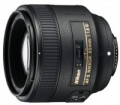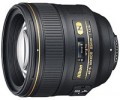Aperture value
Lens aperture is a characteristic that determines how much the lens attenuates the light flux passing through it. It depends on two main characteristics — the diameter of the active aperture of the lens and the focal length — and in the classical form is written as the ratio of the first to the second, while the diameter of the active aperture is taken as a unit: for example,
1 / 2.8. Often, when recording the characteristics of a lens, the unit is generally omitted, such a record looks, for example, like this:
f / 1.8 or
f/2.0. At the same time, the larger the number in the denominator, the smaller the aperture value:
f / 4.0 lenses will produce a darker image than
models with f / 1.4 aperture.
Zoom lenses usually have different aperture values for different focal lengths. In this case, the characteristics indicate two aperture values, for the minimum and maximum focal lengths, respectively, for example: f / 4.5-5.6
The larger the aperture of the lens, the shorter shutter speeds it allows you to use when shooting. This is especially important when shooting fast-moving subjects, shooting in low light, etc. And if necessary, the light stream transmitted by the lens can be weakened using a diaphragm (see below).
Another point that directly depends on this indicator is the depth o
...f field (the depth of space that is in focus when shooting). The higher the aperture, the smaller the depth of field, and vice versa. Therefore, shooting with artistic background blur (bokeh) requires high-aperture optics, and for a large depth of field, you have to cover the aperture.Viewing angles
This parameter determines the size of the area of the scene being shot that falls into the frame. The wider the viewing angles, the larger the area the lens can capture in one shot. They are directly related to the focal length of the lens (see "Focal length"), and also depend on the size of the specific matrix with which the optics are used: for the same lens, the smaller the matrix, the smaller the viewing angles, and vice versa. On our website, in the characteristics of optics, viewing angles are usually indicated when used with the matrix for which the lens was originally designed (for more details, see "Matrix Size").
Minimum focus distance
Minimum focus distance (m) - the smallest distance from which you can focus on an object and take a photo. Usually it ranges from 20 cm for wide-angle lenses to several metres for telephoto. In the macro mode of the camera or with the help of macro lenses, this distance can be less than 1 centimeter.
Internal focus
Lenses using the
internal focus system. In such optics systems, focus is carried out only due to the movement of elements inside the lens body; the outer parts remain completely fixed and the size of the lens does not change. This provides additional convenience — in particular, it allows you to easily use petal hoods and those types of filters for which the correct position on the lens is important (in particular, gradient ones). In addition, the absence of moving elements from the outside has a positive effect on security and resistance to dust / precipitation (although the specific degree of dust and water protection may be different).
Design (elements/groups)
The number of elements (in fact, the number of lenses) included in the design of the lens, as well as the number of groups in which these elements are combined. Usually, the more elements provided in the design, the better the lens handles with distortions (aberrations) when light passes through it. On the other hand, numerous lenses increases the dimensions and weight of the optics, reduces light transmission (for more details, see "Aperture") and also puts forward increased requirements for the quality of processing, which affects the cost of the lens.
Number of diaphragm blades
The number of blades provided in the design of the diaphragm (for details, see "Minimum aperture"). In fact, this parameter is important when shooting scenes with pronounced bokeh (blurred background) and a small depth of field: the more petals the aperture has, the smoother the glare from out-of-focus objects will turn out, while with a small number of petals they can look like polygons. The number of aperture blades has almost no effect on other shooting parameters. Modern lenses have an average of 7-9 petals; the smoothing provided by them in most cases is considered quite sufficient.
Filter diameter
Thread diameter for installation on the filter lens. Light filters are devices for changing the parameters of the light flux entering the lens. They can be used for highlighting individual colours, coloring the entire image in one colour, darkening the image, correcting colour temperature and light balance, shooting in the infrared range, etc. Also, a light filter can play the role of protection against pollution. For successful installation on the lens, the diameter of the filter must match the diameter of the filter specified for this model of optics.

